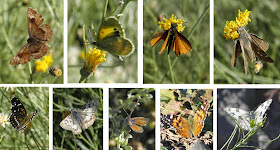 |
| View from Proctor Road towards Green Valley |
Yesterday it was sunny when I left Tucson, but at Madera Canyon a cold wind was whipping the few left-over flowers. Mostly Turpentine Bush, a few Asters, and the tall sticky sun-flower relative that grows along all roads and that I still haven't identified.
.JPG) |
| Ctenucha venosa, Veined Ctenucha a day active tiger moth |
.JPG) |
| Ministrymon leda (Leda Ministreak - Hodges#4291) |
.JPG) |
| Anthanassa texana (Texan Crescent) |
 |
| Urbanus dorantes (Dorantes Longtail) |
There was still water in Madera Creek. Where water seeps into the soil minerals are accessible to insects that many species need for their propagation. Usually the males collect them and pass them to the female during mating.
 |
| Giant Swallowtail - Papilio cresphontes | | |
 |
| Adejeania vexatrix, a tachinid fly at a water seep |
I think the tachinid fly is a female because her eyes are not touching each other on the top of her head. She was very intend on that dry seeming spot of gravel, so I think she also was after minerals rather than water. Or maybe she was hoping to find a host for her parasitic brood here?
 |
| Cylindromyia sp |
.JPG) |
| Copestylum apiciferum |
 |
| Copestylum mexicanum (Mexican Cactus Fly) |
.JPG) |
| small Copestylum sp. |
 |
| Copestylum apiciferum |
 |
| Poecilanthrax sp. |
 |
| Villa sp. |
 |
| Cyphomyia erecta McFadden 1969 |
Only a few insects braved the weather. But wind has a slim advantage for the insect photographer: even the flightiest, shyest bugs sit where they are and hold on for dear live. Bringing the subject into the wind shadow of my body (lucky if that didn't mean shadowing it from sunlight as well) even holding on to the plant with my left hand, I could maneuver the little point and shoot camera rather close to most bugs. The surprising result: a series of fly species.
 |
| Ichneumonid Wasp Compsocryptus sp |
 |
| Bombus sonorus (Sonoran Bumble Bee) |
.JPG) |
| Pogonomyrmex sp.harvesting berries |
 |
| Acromyrmex versicolor, Leaf-cutter Ants, moving 'rocks' to build their chimneys |
Hymenoptera: a few solitary wasps and bees and many social species are still active during fall. Some, like the ants, will survive the winter as whole colonies, but in many species, only the young, mated queens will carry on.
.JPG) |
| Bush Katydid, Scudderia mexicana |
 |
| Red-winged Grasshopper, Arphia pseudonietana |
 |
| Barytettix humphreysii, Humphrey's Grasshopper |
Orthoptera: To me, Grasshoppers and katydids are the character species of the Arizona fall and even winter. The chant of tree crickets was constant at Madera. Occasionally the Horse Lubbers still called and Arphia flew up snarling and flashing red wings. Humphrey's grasshoppers were laying their eggs in the loose sand. No shorthorn grasshopper has an ovipositor, so they push their whole telescopic abdomen deeply into the soil.




























.JPG)
.JPG)
.JPG)




.JPG)

.JPG)






.JPG)

.JPG)







